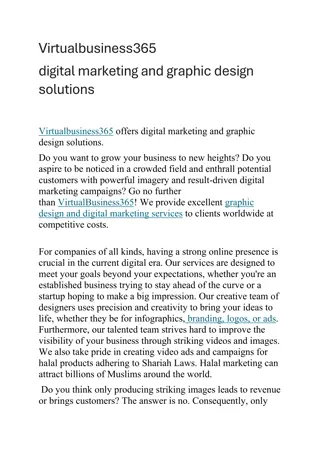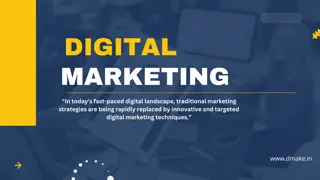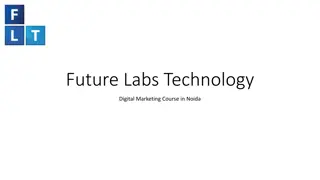Digital marketing fundamentals
The digital marketing environment encompasses both micro and macro elements that influence how organizations operate in the marketplace. Micro-environment focuses on stakeholders and interactions, while macro-environment considers broader forces such as economic, political, and technological influences. Environmental scanning is crucial for monitoring these factors, including online market analysis to enhance competitiveness. Evaluating ecosystems like the Click Ecosystem and understanding customer journeys are essential for effective digital marketing strategies.
Download Presentation

Please find below an Image/Link to download the presentation.
The content on the website is provided AS IS for your information and personal use only. It may not be sold, licensed, or shared on other websites without obtaining consent from the author.If you encounter any issues during the download, it is possible that the publisher has removed the file from their server.
You are allowed to download the files provided on this website for personal or commercial use, subject to the condition that they are used lawfully. All files are the property of their respective owners.
The content on the website is provided AS IS for your information and personal use only. It may not be sold, licensed, or shared on other websites without obtaining consent from the author.
E N D
Presentation Transcript
Digital marketing plan Digital marketing fundamentals: 1. What is Internet/ Digital marketing? 2. the digital marketing environment 3. the digital consumer behaviour Digital marketing information systems Digital marketing strategy development 1. Digital marketing strategy 2. digital marketing mix 3. E-Relationship marketing Digital marketing: implementation and practice
The digital marketing environment I- Definitions The digital marketing environment refers to the contexts in which firms operate. It involves two major elements: Micro-environment: (The operating environment). It focuces on the players (stakeholders) and their interactions which influence how an organisation responds in its marketplace. Macro-environment: (the remote environment) Broad forces affecting all organisations in the marketplace, including economic, political, legal and ecological influences. social, technological,
The digital marketing environment Market analysis: The environment can have a profound impact on performance; consequently an organisation should continually monitor the environment (micro and macro). This process is called environmental scanning, or market analysis. Online market analysis: helps to define the nature of the e-competitive market (the click ecosystem).
The digital marketing environment Click Ecosystem describes the flow of online visitors between search engines, intermediaries to an organisation and its competitors. Online market ecosystem is the connection of websites through data exchange, giving opportunities to enhance the customer experience and extend their reach and influence. Facebook platform is an ecosystem that enables other site owners to incorporate information about consumer Facebook interactions into their own websites and apps and share social objects across the Facebook ecosystem to extend their reach Google Android ecosystem is Google`s ecosystem media sites, other
The digital marketing environment Companies have to evaluate the relative importance of these ecosystems and the resources they need to put into integrating their online services with them, to create a plan.
The digital marketing environment II- Customer journeys Customer journeys is a term used to describe touchpoints or different types of paid, owned and earned media which influence consumers as they access different types of website and content when selecting products and services. Customer journey maps: to help understand different customer journeys to purchase, customer journey maps are a technique used to model behaviour of different audience personas An example of a customer journey map
The digital marketing environment II- Customer journeys
The digital marketing environment II- Customer journeys Google has developed a retail-specific model for understanding customer discussed in marketing known as the Zero Moment of Truth journeys, widely (ZMOT) A summary of today s multichannel consumer decision making for product purchase where they search, review ratings, styles, prices comments on social media before visiting a retailer.
The digital marketing environment II- Customer journeys A consumer`s journey is emotional, trigged by need or want, influenced by direct and indirect brand messages, friends, WOM. It is not necessarily anything to do with brand owners, or their advertising .
The digital marketing environment II- Customer journeys Consumer`s preconceived ideas, often enabling a rapid forming of an early consideration set for research and exploration, in store, at home online, or via mobile on the move
The digital marketing environment II- Customer journeys Product or brand based research ssss brands added and subtracted to the early consideration set. Based upon price, performance, online reviews, in-store brousing and social media .
The digital marketing environment II- Customer journeys A final shortlist is set. Based upon the evaluation phase, products are viewed and reviewed either online {desktop and mobile} or at shelf in store, possibly both at the same time { . . }
The digital marketing environment II- Customer journeys The moment of purchase and associated experience is central to how the consumer feels about the brand, as well as the retailer, before consumption takes place, are they excited or impartial
The digital marketing environment II- Customer journeys Unwrapping, unboxing and using, the consumer now has new information for future brand purchases, as well as the case and means to share those experiences, creating a brand foot print for future consumers to follow .
The digital marketing environment II- Customer journeys Some triggers come with automatic brand selection based on previews experiences, advocacy born of emotions, trust, deep beliefs and relationship .
Eater TechCrunch
The digital marketing environment II- Customer journeys Lifecycle segmentation is a marketing strategy that involves dividing a target audience into distinct groups based on where they are in the customer journey or product lifecycle. The customer lifecycle typically consists of several stages, such as awareness, consideration, purchase, retention, and advocacy. The purpose of lifecycle segmentation is to create targeted marketing campaigns and messages that are relevant to each stage of the customer journey. For example, customers in the awareness stage may require different messaging than those in the retention stage. By tailoring marketing messages to each stage, marketers can improve engagement, increase conversions, and build stronger relationships with customers.
The digital marketing environment II- Customer journeys Vertical search engines, also known as specialized or topical search engines, are search engines that focus on specific industries, topics, or types of content. Unlike general search engines like Google or Bing, which index and search the entire web, vertical search engines limit their scope to a particular niche. (LinkedIn, Expedia .) Specialist directories are online directories that focus on a specific industry, topic, or type of content. These directories are similar to vertical search engines, but they often function as a more structured way to organize and display information about a particular niche. (Business directories like Yelp or Yellow Pages, industry-specific directories like Thomas Net or TechCrunch, which focus on particular industries or technologies .)
The digital marketing environment II- Customer journeys























